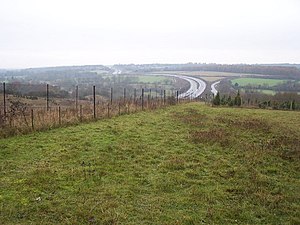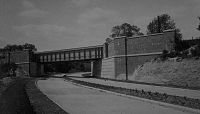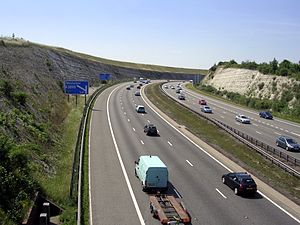Twyford Down

Twyford Down is an area of chalk downland lying directly to the south-east of Winchester, Hampshire, next to St Catherine's Hill and close to the bounds of the South Downs National Park.
At the south of the downland, as it descends to the Itchen Valley,, is the village of Twyford from which the down takes its name.
The down has been settled since pre-Roman times, and has housed a fort and a chapel, as well as being a 17th and 18th century coaching route.
In 1991, the down was the site of a major road protest against a section of the M3 motorway from London to the south coast. The work, carving a vicious slice through the down, was described in 1994 as the most controversial British motorway project ever to start construction,[1] attracted a wider range of classes of people than had previously been the case, and included physical violence from onsite security officers.
History
Twyford Down sits to the southeast of Winchester and the northeast of Twyford, and is part of the Winchester-East Meon Anticline.[2] The down's 466-foot summit, known as Deacon Hill, is towards the north-eastern edge of the area which is renowned for its dramatic rolling scenery and ecologically rich grassland.[3]
The hand of man upon these hills can be traced back to pre-Roman times. Along it run a series of trackways known as "dongas", carves by the feet of countless generations of farmers herding animals to surrounding markets. St Catherine's Hill, in the centre of the down has been identified as a human settlement more than 3,000 years ago and pre-dates the foundation of Winchester. In the 3rd century, a fort was constructed on the hill, while in the 12th, a Norman chapel was constructed on the site.[4]
In 1675, John Ogilby noted that the main coaching route from London to Southampton ran over the top of the down, going directly from Alresford to Twyford, avoiding Winchester. This remained the main coaching route until about 1800, when an alternative route via Winchester (now mostly the A31 and former A33) was formed.[5] During this time, and up to the 19th century, the area was sometimes known as Morestead Down after the nearby village of Morestead.[6]
Hockley Golf Club was established as a private members' club on the down in 1914.[7]
The M3 motorway extension
Background

Outline strategic planning for the route of what was to be later known as the M3 motorway had begun in the late 1930s. The route was to link London to Basingstoke, in order to reduce the pressure on the A30. Detailed planning for the first phase of construction (a forty-mile section, between Sunbury on Thames and Popham) began in 1962-3.[8] It continued slowly over the decades following until the third and final phase, to extend the motorway from Winchester to Southampton and the M27 motorway.[8]
The Winchester bottleneck was hampering traffic to and from the docks at Southampton: several major routes passed through the historic city centre, including the A31, A33, A34 and A272. In the 1930s, a by-pass was built to the east of the city, passing immediately west of St Catherine's Hill, opening to traffic on 1 February 1940.[9] It was insufficient for post-War traffic however: the M3 was required. The original plan for a motorway had it going through the Itchen valley, which was eventually rejected due to intensifying local pollution and disturbance.[10] In the meantime, traffic to and from Southampton Docks was still stuck in the bottleneck. In 1983, the consulting engineers Mott, Hay and Anderson had submitted a recommendation to complete the M3 through Twyford Down, and this was chosen. A tunnel would have been prohibitively expensive, so it was to be put in a cutting.
Protests
Protests against the completion of the M3 had been ongoing since 1973, with the formation of the M3 Joint Action Group, and it gathered together a petition of 19,000, of which 11,227 were Winchester residents. The group was also active in distributing leaflets to the local community.
In March 1992, two 'New Age' travellers itching on the down learned of the plan decided to gather opposition.[11] Environmental organisations attempted to take Department for Transport to the High Court, stating that the road was against the government's own environmental protection laws.[12] The European Commission dropped its objections that August. David Croker, who had become head of the protest group Twyford Down Association, said they "had come to depend on the European Commission so we're very disappointed."[13] The principal arguments of the protesters were their concern about making wildlife species, such as the Chalkhill Blue butterfly, extinct, putting a highly visible scar on the landscape, and that they believed the new motorway would not adequately resolve traffic problems.[14]
Protesters demonstrated their opposition to the road's construction by blocking the path of construction equipment.[15] They were met by security officers from Group 4. In December 1992, in view of a film crew from The Observer, a protester was manhandled by five officers.[1] Another protester, according to a report by local MP John Denham, was strangled by officers and left unconscious on top of the Down for 30 minutes.[1] Maggie Lambert, then a mature photography student, took numerous photographs of the protest, and challenged an injunction which suggested she had been involved with direct action. While Lord Justice Mann admitted there was no evidence to suggest she had done anything more than take photographs, the injunction was upheld.[1] Protester Rebecca Lush of the 'Donga Tribe', who had stayed on the down from September to the night of eviction, later claimed "It was a horrific experience and very violent. We were dragged through thorns and we were being kicked and punched and someone pulled out a clump of my hair."[16]
The protest attracted different classes of people, the many of whom were peaceful. According to Denham, a popular phrase amongst those protesting was "I never thought that I would find myself doing something like this."[1]
Outcome

In 1995, the motorway section through Twyford Down was opened, making the M3 a continuous motorway. The old A33 Winchester Bypass between Bar End and Compton was then closed and removed. The new cutting caused the loss of 4¾ acres of SSSI land. To redress this, the old route of the A33 was planted with 18 acres of species-rich grassland under the supervision and monitoring of the Institute of Terrestrial Ecology.[17] Replacing the bypass also reduced traffic volumes from the village of Twyford and removed the road that separated St Catherine's Hill from the city. When interviewed for The Independent, local residents said the latter had transformed the place, one adding "St. Catherine's Hill used to be cut off from Winchester by the A33. Now there's open, peaceful countryside. It's wonderful."[10]
In 2004, Winchester Cathedral received £86,000 from the Highways Agency in compensation for increased traffic noise from the M3.
In 2012, several of the original protesters returned to the down to hold a 20th anniversary celebration of the protest.[18]
Twyford Down became part of the western extremity of the South Downs National Park in 2011, having previously been designated as part of the East Hampshire AONB (Area of Outstanding Natural Beauty).[19]
Location
- Location map: 51°2’41"N, 1°16’47"W
- Streetmap: SU506275
Outside links
- The Winchester Bypass on SABRE
- Photo gallery of mass trespass from Urban75
- BBC Hampshire webpage containing summary of Twyford Down's historical and contemporary significance.
- British Library page with short relevant section under heading of Dreamers and Dissenters — Treehouse and Tunnels.
References
- ↑ 1.0 1.1 1.2 1.3 1.4 John Denham (2 December 1994). "Twyford Down". Hansard. http://hansard.millbanksystems.com/commons/1994/dec/02/twyford-down. Retrieved 18 January 2013.
- ↑ Map: 'Winchester': British Geological Survey England and Wales, 1:50000
- ↑ "Hampshire Conservation Volunteers : Deacon Hill". Hampshire County Council. http://www.hcv.hampshire.org.uk/hcvsites/deaconhill.htm. Retrieved 18 January 2013.
- ↑ "Spiritual Places – Twyford Down". BBC Hampshire. 9 March 2004. https://www.bbc.co.uk/southampton/features/spiritual_places/spiritual_places2.shtml. Retrieved 18 January 2013.
- ↑ "Old Hampshire mapped". Geography department, University of Portsmouth. http://www.geog.port.ac.uk/webmap/hantsmap/hantsmap/roads/r3notes.htm. Retrieved 18 January 2013.
- ↑ "Milne's map of Hampshire". 1791. http://www.geog.port.ac.uk/webmap/hantsmap/hantsmap/milne1/mln54.htm. Retrieved 18 January 2013.
- ↑ "Hockley Golf Club – How to join". http://www.hockleygolfclub.com/pages.php/how_to_join.html. Retrieved 18 January 2013.
- ↑ 8.0 8.1 Baldwin, (Sir) Peter; Baldwin, Robert; Evans, Dewi Ieuan (2007). "Chapter21: M3 – London to Southampton". The Motorway Achievement: Building the Network in Southern and Eastern England. Chichester: Phillimore & Co (for Motorway Archive Trust). pp. 171–188. ISBN 978-1-86077-446-1.
- ↑ "Winchester by-pass open tomorrow". The Times (48527): p. 5. 31 January 1940.
- ↑ 10.0 10.1 Roger Bell (18 June 1995). "Infamous traffic lights go back to nature". The Independent. https://www.independent.co.uk/news/uk/home-news/infamous-traffic-lights-go-back-to-nature-1587010.html. Retrieved 22 January 2013.
- ↑ Monbiot, George (21 February 1997). "Multi-issue Politics". Times Literary Supplement (News International). http://www.monbiot.com/archives/1997/02/21/multi-issue-politics/. Retrieved 10 January 2008.
- ↑ Social Movements: Transformative Shifts and Turning Points. Routledge. 2017. p. 314. ISBN 978-1-317-34205-2.
- ↑ Tim Jackson; Nicholas Schoon (1 August 1992). "EC clears way for road link at Twyford Down". The Independent. https://www.independent.co.uk/news/uk/ec-clears-way-for-road-link-at-twyford-down-1537351.html. Retrieved 22 January 2013.
- ↑ "Learning Zone : Extending the motorway at Twyford Down". BBC News. https://www.bbc.co.uk/learningzone/clips/extending-the-motorway-at-twyford-down/5462.html.
- ↑ Miller, Chris (2012). Environmental Rights: Critical Perspectives. Routledge. p. 86. ISBN 978-1-134-69786-1.
- ↑ "Campaigners vow to fight road plans on Twyford Down 20th anniversary". Hampshire Chronicle. 3 October 2012. http://www.hampshirechronicle.co.uk/news/9962984.Campaigners_vow_to_fight_road_plans_on_Twyford_Down_20th_anniversary/. Retrieved 22 January 2013.
- ↑ "Taming The Tarmac: The Lesson of Twyford Down". Cambridge University. Archived from the original on 29 November 2006. https://web.archive.org/web/20061129051942/http://www7.caret.cam.ac.uk/twyford_intro.htm. Retrieved 10 January 2007.
- ↑ John Vidal (28 September 2012). "Twyford Down's Dongas return 20 years after M3 protest". The Guardian. https://www.theguardian.com/world/2012/sep/28/twyford-down-20years-m3-protest.
- ↑ Department for the Environment, Food and Rural Affairs. "Map of South Downs National Park". http://www.southdowns.gov.uk/__data/assets/pdf_file/0011/122969/Confirmed_boundary_for_South_Downs_National_Park.pdf. Retrieved 6 March 2013.
- Bryant, B (1995). Twyford Down: Roads, Campaigning and Environmental Law. E & FN Spon. ISBN 0-419-20270-6.